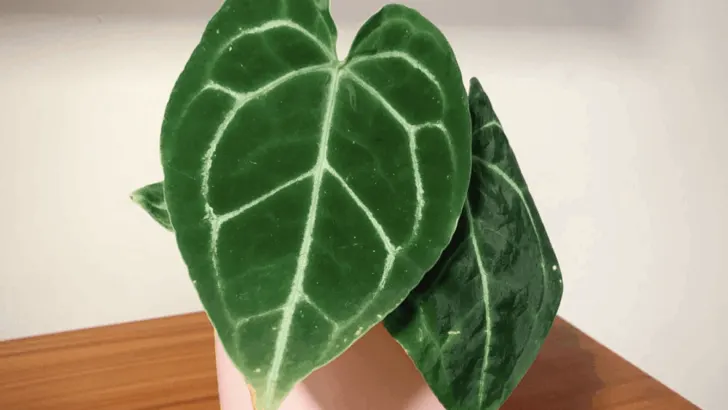(image credit, IG: brownthumbelina)
If you want to know everything about Anthurium chrystallinum care, you came to the right place.
Everything I know about growing wondrous tropical evergreens from the genus Anthurium, from the family of Araceae, I learned from my grandmother.
She bought her specimen of Anthurium crystallinum with just two yellowing leaves and nurtured it back to full health.
I love the velvety texture as well as the heart-shaped leaves. To be honest, I cannot get enough of it. My goal is to grow the beautiful leaves as big as possible.
Anthurium crystallinum Takeaways
| Species | Anthurium chrystallinum |
| Synonyms | Crystal laceleaf plant |
| Family | Araceae |
| Genus | Anthurium |
| Growth | Forming rosettes with large heart-shaped leaves. |
| Height | 3 feet (90 cm) |
| Width | 2 feet (60 cm) |
| Soil | Well-draining soil mix using peat, perlite, charcoal and orchid bark |
| Watering | Water every 7 to 14 days |
| Light | Bright indirect |
| Temperature | 65 to 75°F |
| Humidity | 70-80% |
| Fertilizer | Fertilize monthly in spring and summer |
| Propagation | Stem cuttings, divisions |
| Toxicity | Poisonous to cats, dogs, horses and humans. Contains oxalate crystals. |
ANTHURIUM CRYSTALLINUM CARE SUMMARIZED
To care for Anthurium crystallinum keep a temperature between 65 to 75°F (18 to 24°C). Use an airy potting mix that can hold moisture but is fast draining using orchid bark, perlite, and compost. Provide bright indirect light and high humidity in the 70-80% range. Fertilize once a month in spring and summer.
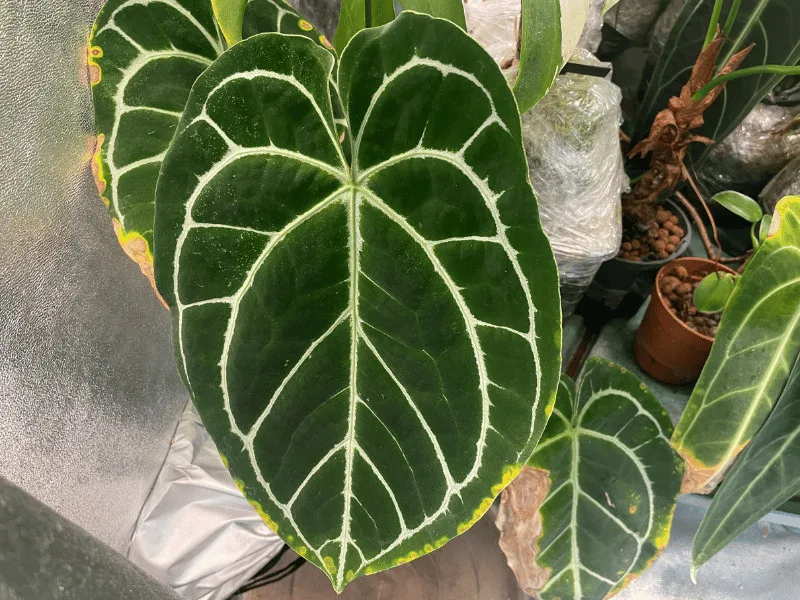
When the first healthy leaf popped up, we huddled around it to admire the striking silvery white venation against the deep green leaves. The whole leaf had a silvery velvety sheen to it.
The leaves are heart-shaped but with a twist. The anterior lobes look almost sealed together, making the leaf look oval. The underside is coppery colored.
With proper Anthurium crystallinum care, within a year it started to flower. The blooms consist of a spathe (a modified leaf) and a spadix. Grandma didn’t particularly care for the flower because it has thin spathe of a dull purplish-brown color. She said it looked old from day one but admitted the pleasant fragrance. Water regularity about once a week, but ensure the water drains fast.
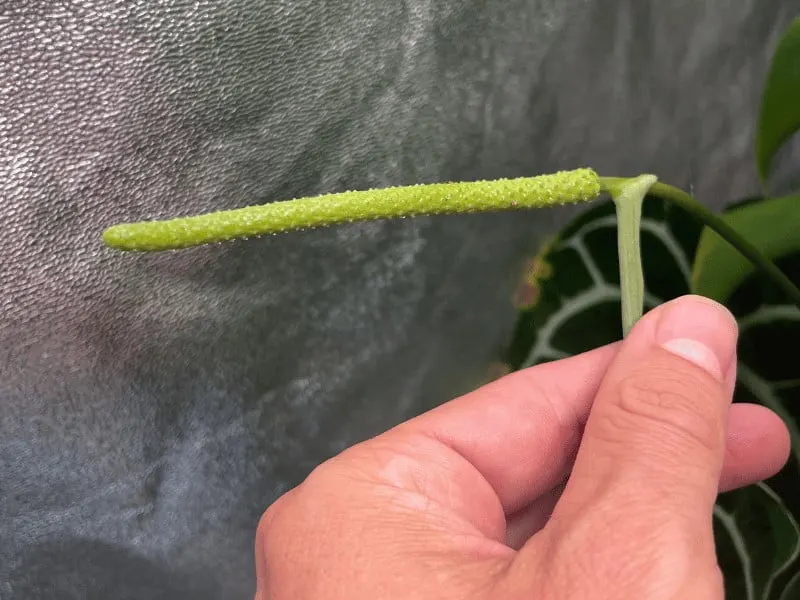
Anyway, she grew the Crystal laceleaf plant (its common name) for the foliage, and that was that. The foliage itself is light to dark green. The veins on the leaves are beige to silvery. They sparkle when the sun shines.
I will share with you Grandma’s Anthurium crystallinum care hacks so that you can grow this plant as successfully as her.
Table of Contents
ANTHURIUM CHRYSTALLINUM GROWING VIDEO
ANTHURIUM CRYSTALLINUM CARE GUIDE
Soil
You can grow Anthurium crystallinum in a wide range of soils and potting mixes. A potting mix that’s porous and has good water retention properties works great.
Anthuriums are aroid plants. Aroids are mostly epiphytes.
Anthurium crystallinum is a perennial epiphyte originally found in Central America growing on tree tops or terrestrially on the sides of hills.
These plants grow air or aerial roots to hold onto other objects and plants. These roots do not like compact soil. Airlfow to the roots is crucial. The roots themselves can take in oxygen. They will also suffocate if the soil is compacted leading to root rot.
Grandma made her potting mix made of dried sterile garden compost and broken shells of walnuts, almonds, pistachios, and even coconuts – basically anything organic.
To this, she added plenty of charcoal and brick bits. She made a mixture that had plenty of air pockets to grow Anthurium crystallinum so that the roots could breathe.
Now her mix may be difficult for you to organize. So, one Anthurium crystallinum care hack is to simply purchase good quality orchid soil and mix it with gravel and perlite.
Place this coarse mixture in a terracotta pot layered with gravel or brick bits, or coconut shells to further assist root aeration and drainage.
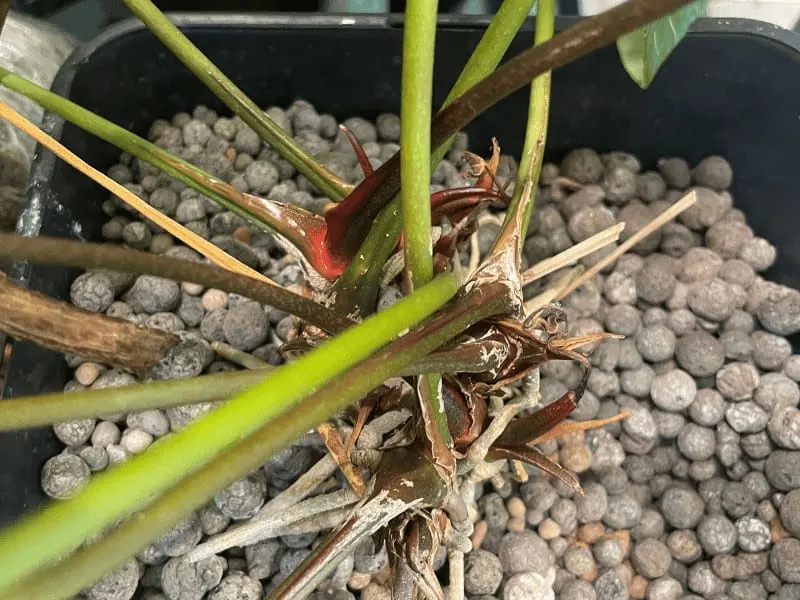
Light
Anthurium crystallinum care requires 70-85% sunlight, in other words, consistent exposure to bright indirect light.
Grandma used to grow Anthurium crystallinum in bright shade by the kitchen window. She used to say direct exposure burned the leaves.
Outdoors you can either grow Crystal Anthurium under a 20-40% shade cloth or under the share of a tree.
This is a true tropical evergreen with a hunger for long days. Grow lights are a vital part of the Anthurium crystallinum care winter essentials.
Under low light conditions, the plant grows incredibly slowly.
Watering the right way
Water every 7-14 days. Check the potting mix with your index finger. If it is dry or almost dry water the plant thoroughly.
Anthurium crystallinum care should resemble their natural environs in the tropical rainforests of Panama where it’s quite wet. But you must note how they grow. Their roots are exposed to air and dry out as quickly as they get wet.
If the potting mix and the planter you’ve used drain excellently well, then yes, you can water regularly.
Grandma’s chunky soil mix worked very well for drainage. She used to water about twice or even thrice a week in summer. In winter, she used to water once in two weeks with lukewarm water.
A couple of Anthurium crystallinum care hacks I got from her were to save up rainwater in a barrel in the backyard and water with that OR to use the water of the garden fish tank. All that fish manure is like ambrosia for the plant.
Temperature
One thing I can say for sure about Anthurium crystallinum care is that it is warmth loving. You can grow Crystal Anthurium in ambient temperatures ranging from 65 to 75°F (18 to 24°C).
In the northern zones, they should be brought indoors for outwintering. If you grow Anthurium crystallinum in a greenhouse, it should be heated and well-ventilated, avoiding draughty windows and extreme temperature fluctuations. The bare minimum temperature is 55°F (13°C).
Humidity
This plant is a sucker for high air humidity. In the native environs, these plants are exposed to constant water evaporation.
High humidity levels between 70% to 80% work ideally to grow Anthurium crystallinum. That’s why Grandma chose the kitchen window spot where boiling pots always kept the air humid.
Another Anthurium crystallinum care hack is to grow in your bathroom provided you have a well-lit easter or western window or grow lights.
You can also adapt these indoor plants to lower humidity levels.
Fertilizer
Use a well-balanced fertilizer monthly in spring and summer. Reduce fertilization to once every two months in autumn and winter.
Like any houseplant, our Crystal Anthurium has its nutrition needs for optimum growth. But Anthurium crystallinum care needs little once the potting mix is well enriched with organic content.
Grandma’s answer to feeding was fish emulsion well diluted and administered once a month. Otherwise she used the water from the fish tank.
The reason I prefer organic feeds over chemical fertilizers, particularly for epiphytes like Anthurium is because they are slow-release. I am not opposed to a balanced orchid fertilizer in the bi-monthly Anthurium crystallinum care schedule, which you can pick up from your local store.
Potential salt build-up from chemical fertilizers can destroy your plant, so you should regularly flush the entire root ball with thorough and deep watering.
Propagation
The propagation methods for Crystal Anthurium are pretty straight forward, but the results may not always be consistent.
The simplest way is to separate plantlets from the roots as and when they appear, but you need to depend on nature’s family planning.
Root separation is the most reliable method to propagate Anthurium crystallinum.
Many professional nurserymen will save the seeds from the berries on the spadix to germinate them, but the environment has to be very precise otherwise, the seeds simply rot away.
Growth
Crystal Anthurium is a real slow grower. It gives one new leaf in about 3 to 4 weeks. Their growth pattern is self-heading and takes up a lateral space.
The leaf blades are medium-sided, occasionally growing to a maximum of 30 cm (12 inches) in the home environment. They’re fairly compact and suitable for indoor growing.
Patio in summer and a greenhouse in winter is ideal for those who live in the colder zones.
If you’re lucky enough to have more moderate temperatures, then by all means, plant the Crystal Anthurium straight in the ground in the yard. They make great background covers.
Anthurium crystallinum care doesn’t involve much pruning – just periodical deadheading of dry leaves and inflorescences is good enough.
Potting
Potting is quite a simple process when you grow Anthurium crystallinum. Layer a small pot with organic rubble, place the plant in the pot, and pour in the chunky mixture around the roots.
This plant allows experiments with different planters. Grandma tried to grow Anthurium crystallinum (and several other Anthuriums) in sleeves made of intact coconut husk, which she tied around a tree trunk. This I am told is a great way to grow epiphytes because of the natural drainage in this setup.
You can you grow Anthurium crystallinum root-bound. You don’t need to repot until the roots look suffocated and stop drying out well enough. That’s about once in two years or so.
You have to pick up the plant from one shallow planter and place it in the next, arranging the roots widely. Supplementing the soil with organic material and application of a balanced well-diluted fertilizer helps at the time of repotting.
ANTHURIUM CRYSTALLINUM PROPAGATION STEP BY STEP
Propagate Anthurium crystallinum root division
This is a reliable method, but I would recommend it only if your Anthurium crystallinum is strong and mature, i.e., at least a year old.
- Wait until the start of spring or summer to remove the entire plant from its planter.
- Gently remove the soil around the root system until you see the thick stem at the center.
- This subsoil stem needs to be cut into half – the top half with the leaves and a few roots and the bottom half which be stump with the remaining roots.
- Make sure both cuttings have a few roots.
- Rest them for a day for the cut to callous before you plant the two halves in individual pots.
- For the bottom half, ensure the stump is visible above the soil mix.
- Keep the soil slightly moist but maintain high humidity with a plastic bag with holes.
- Feed them with very dilute good quality fertilizer until the plant picks up and stabilizes.
Propagate Anthurium crystallinum through plantlets
You’re at the mercy of nature as far as this method is concerned. In mature plants you may sometimes see young plantlets at the roots.
These are attached to the stem from the bottom. At the start of the growing season, you can separate the plantlet just like the root division method.
This is a reliable method but will diminish the bushy look of your plant. I would recommend it only if your Anthurium crystallinum has outgrown its container and the roots emerge from the drainage holes or over the sides of the pot.
COMMON PROBLEMS WITH ANTHURIUM CRYSTALLINUM
Leaf spots like burn marks: These are often a bacterial infection that spreads by overwatering or wet leaves. They remain asymptomatic for many months and once visible they spread fast. The affected leaves have to be quickly cut with sterile sheers and discarded far away.
Yellowed (chlorotic), lesions along the leaf margins: If the lesions are water-soaked and develop into a dark brown colour then this is bacterial blight. The treatment is as above.
Yellowing and sudden wilting even if the plant is well watered: Check the roots. If they have died back then the cause is Pythium fungal infection that spreads due to water logged soil.
According to the University of Florida, almost every disease affecting Anthuriums is closely linked to overwatering and excess humidity. You must grow Anthurium crystallinum in relatively dry environments compared to other tropicals.
Anthurium crystallinum is fairly pest resistant but can sometimes get sucking pests like aphids, spider mites, and mealybugs. These sap-sucking pest feed on plant nutrients and discrete sticky honeydew, which attracts other insects.
Pests can be treated by spraying your plant with a regular insecticidal soap once a week. You can also dab these insects with a cotton ball dipped in isopropyl alcohol. Remove the dead insects from the plant using a damp cloth.
Regular wiping of the leaves with a damp cloth is a very reliable preventive for pest problems.
TIPS FOR GROWING ANTHURIUM CRYSTALLINUM
- The most important point to remember about Anthurium crystallinum care is that they love their roots getting washed but they also love to get dry after that.
- The best way to achieve this is by managing the soil mix. As organic, chunky and clunky as it get.
- Don’t splash the leaves often. Wipe them dry after watering.
- Maintain high humidity by huddling up the plant with other plants to create a micro humidity zone
- Grow Anthurium crystallinum in a terracotta pot where the roots get to breathe. This helps in disease prevention.
- Check that the roots are cream-colored with a pink tinge. That’s a sign of health.
- These are warmth lovers and can’t tolerate the slightest frost. You need to outwinter them inside a greenhouse.
- They are not heavy feeders. Stick to organic soil supplements like fish emulsion.
SIMILAR PLANTS TO ANTHURIUM CRYSTALLINUM
The most similar plants to Anthurium chrystallinum are:
- Anthurium clarinervium: Clarinervium also have heart-shaped leaves but darker leaves and a less sparkly venation on the adaxial leaf side.
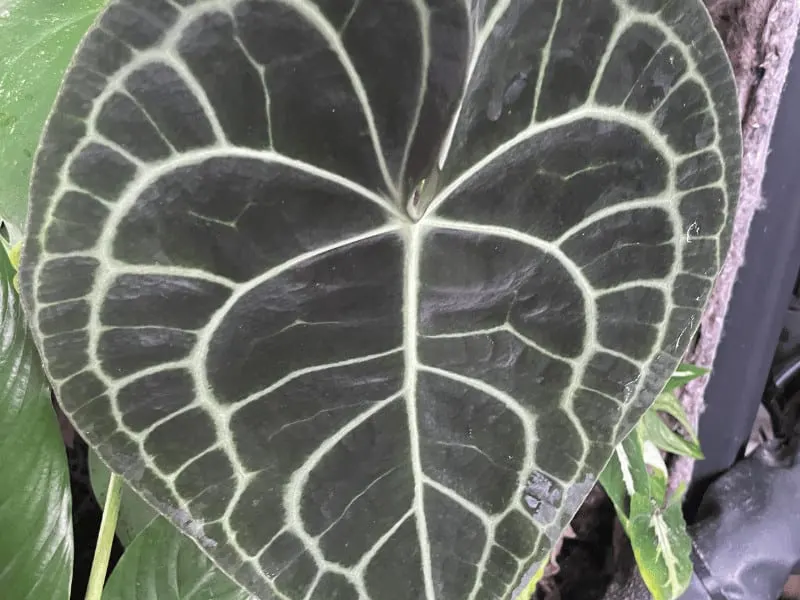
- Anthurium magnificum: The magnificum has larger leaves and less pronounced stripes or vines
- Anthurium crystallinum magnificum: Is a cross between the two and has features of both plants. It is also written as Anthurium crystallinum x magnificum. Grows taller leaves because of the magnificum genes
FREQUENTLY ASKED QUESTIONS ABOUT ANTHURIUM CRYSTALLINUM
How long before I have to repot Anthurium crystallinum?
The best to refresh the potting soil every year or two years. As the soil ages, the infection causing bacteria and fungus starts building up around the roots. Repotting is a good time to check the health of the roots. Make sure there are no brown, slushy roots.
Is Anthurium crystallinum toxic for pets?
The plant contains oxalic crystals that can irritate the mouth, intestinal tract, and throat if swallowed. Even the sap can cause allergic reactions.
How do I increase Anthurium crystallinum blooms?
Encourage your Anthurium crystallinum to bloom with diluted phosphorus-rich fertilizer or a good orchid fertilizer. Also supply plenty of indirect sunshine and the right watering levels.
Should Anthurium crystallinum be misted?
Maintaining a high humidity level is desired. You can mist your plants daily but ensure that the leaves do not stay too wet for too long otherwise fungus will start to build on the leaves in form of leaf spots.
CONCLUSION
Grandma loved anthuriums in general and grew a variety of them mainly for the flaming red or pink inflorescences.
After she started to grow Anthurium crystallinum, foliage anthuriums became a thing in her garden. She obviously didn’t stop at one.
Shortly after Crystallinum she expanded her collection to include more spectacular foliage exotics like Anthurium Metallicum, Anthurium Magnificum and Anthurium Regale.
The thing about Anthuriums is that each species has subtly different needs. I wouldn’t describe them as neglect proof or easy maintenance. But with our detailed care guides you can definitely learn to grow them successfully.
Happy gardening!

Daniel has been a plant enthusiast for over 20 years. He owns hundreds of houseplants and prepares for the chili growing seasons yearly with great anticipation. His favorite plants are plant species in the Araceae family, such as Monstera, Philodendron, and Anthurium. He also loves gardening and is growing hot peppers, tomatoes, and many more vegetables.

